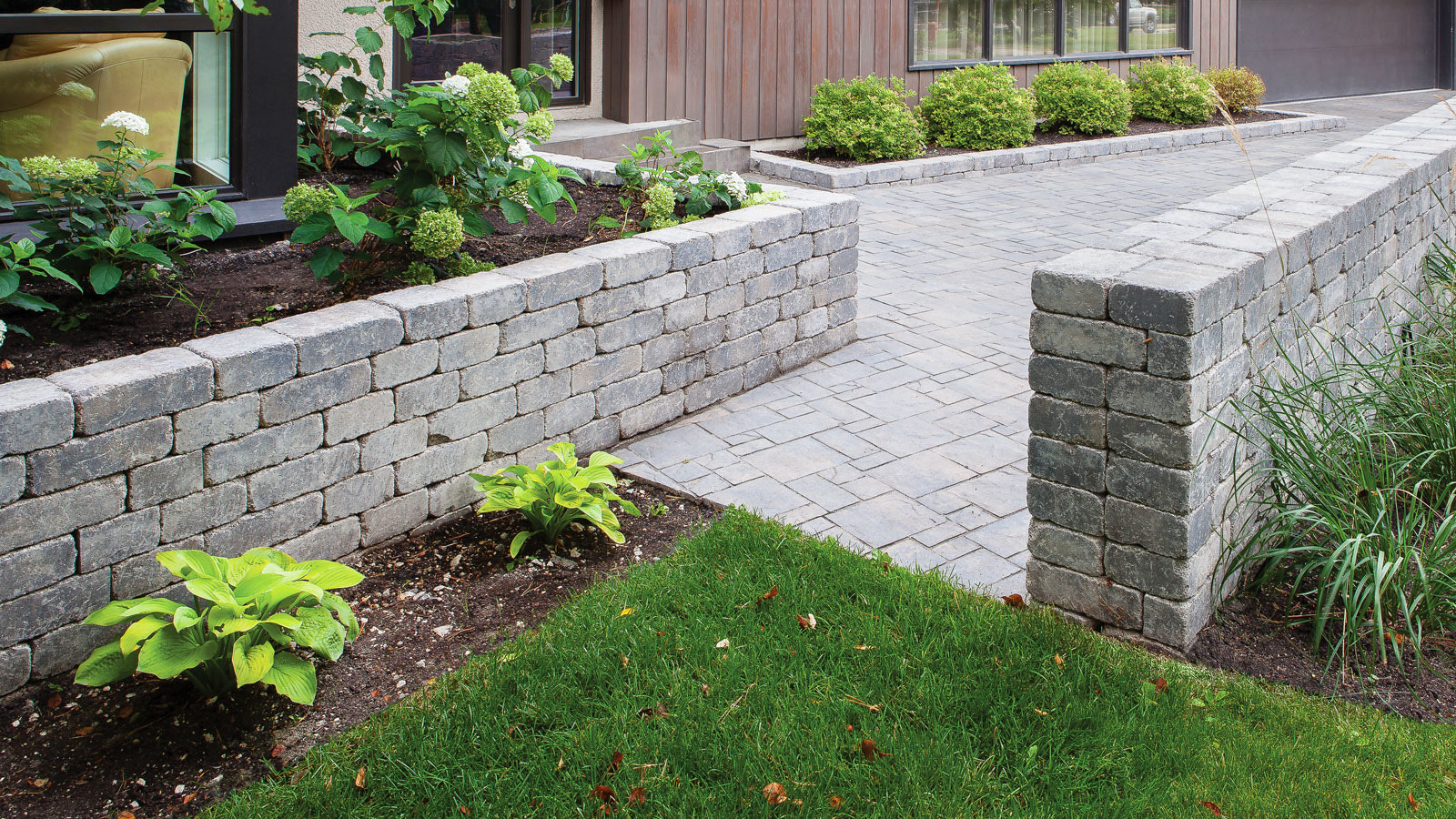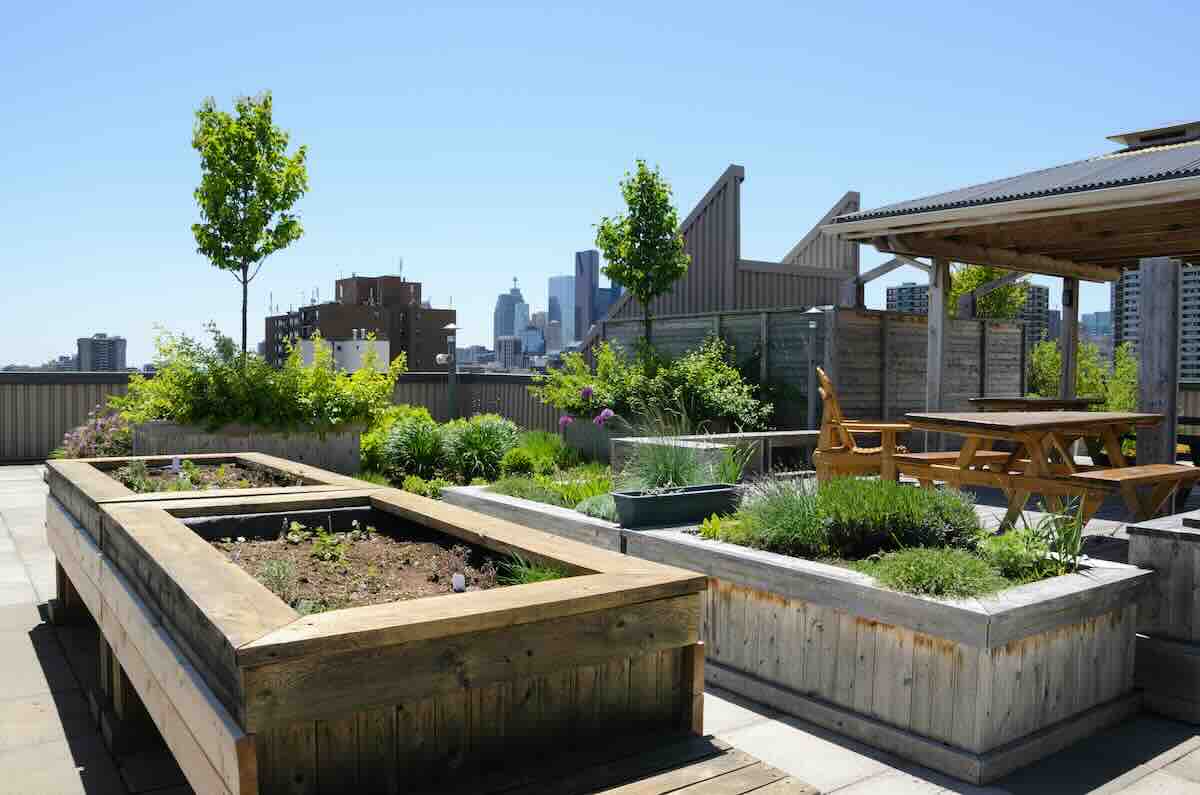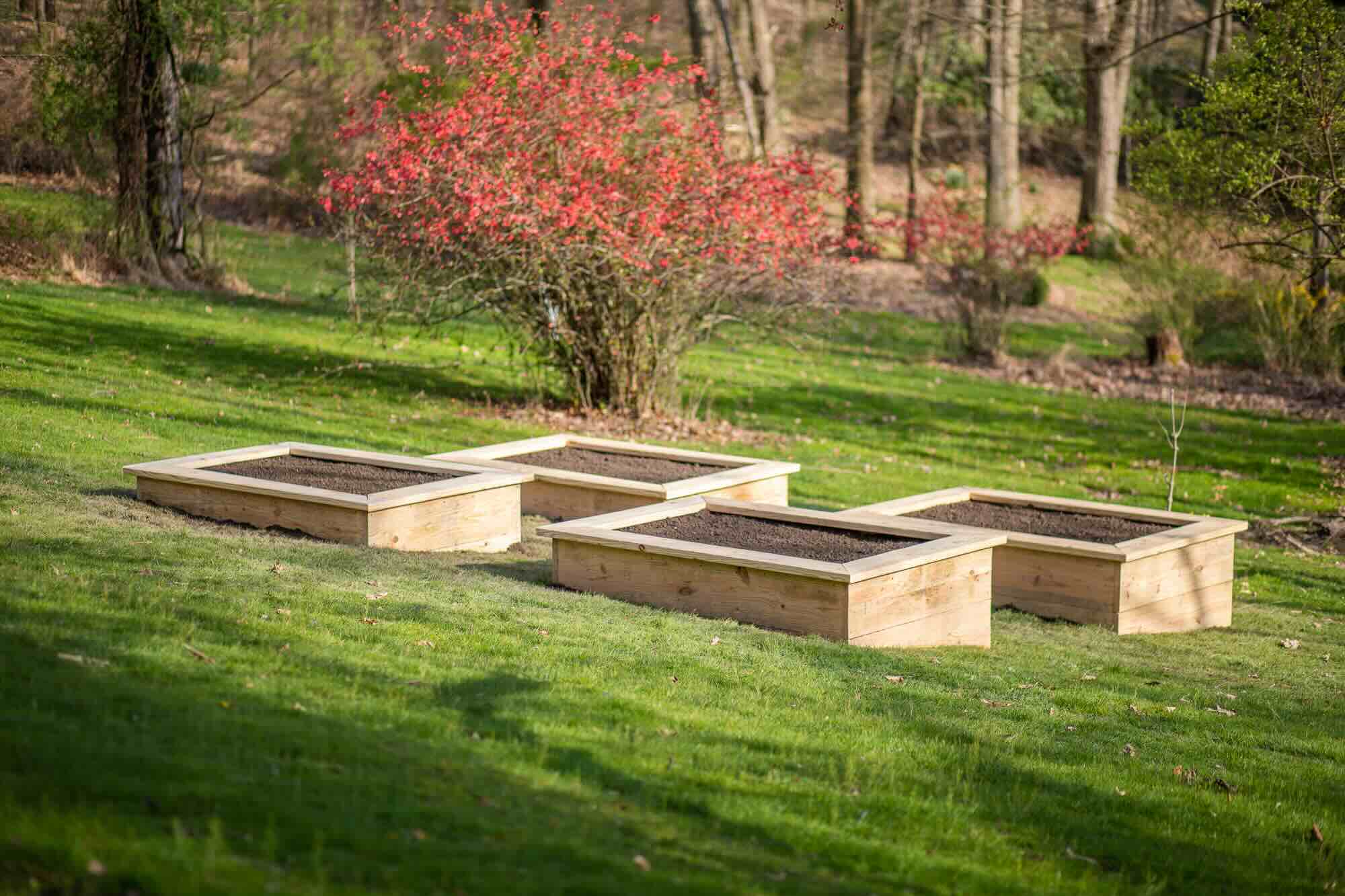

Articles
How To Build A Garden Retaining Wall
Modified: February 28, 2024
Discover the step-by-step process of building a sturdy garden retaining wall. Enhance your gardening skills with this comprehensive guide on DIY garden wall construction.
(Many of the links in this article redirect to a specific reviewed product. Your purchase of these products through affiliate links helps to generate commission for Storables.com, at no extra cost. Learn more)
Introduction
Welcome to the world of gardening! If you’re looking to transform your outdoor space and add a touch of elegance, a garden retaining wall is the perfect project for you. Not only can it be a visually stunning addition to your landscape, but it also serves a practical purpose of holding back soil and preventing erosion. Whether you want to create terraced garden beds or add a level space to your yard, building a retaining wall is a great way to achieve both beauty and functionality.
Before diving into this exciting project, it’s important to have a solid understanding of the process involved in constructing a garden retaining wall. From planning and preparation to the final touches, each step requires careful consideration and attention to detail. In this comprehensive guide, we will walk you through the process, providing valuable tips and guidance along the way.
Before you begin, take some time to assess the area where you want to build the retaining wall. Consider the purpose of the wall and the desired aesthetics. Determine whether you need a small decorative wall or a larger structural wall. This will help you determine the materials and techniques that are suitable for your project.
In the next section, we will discuss the planning and preparation phase, which is crucial for the success of your retaining wall project. So, grab your gardening gloves, and let’s get started on building your dream garden retaining wall!
Key Takeaways:
- Building a garden retaining wall requires careful planning, the right materials, and precise construction. It adds both beauty and functionality to your outdoor space, creating a stunning and durable structure.
- Incorporating finishing touches such as capstones, vegetation, lighting, and decorative elements enhances the visual appeal and functionality of the retaining wall. Regular maintenance is essential to ensure its longevity and beauty.
Read more: How To Build A Brick Retaining Wall
Step 1: Planning and Preparation
Before you start construction on your garden retaining wall, it’s essential to carefully plan and prepare for the project. This step will lay the foundation for a successful and long-lasting structure. Here are some key factors to consider:
1. Assess the Area:
Begin by evaluating the area where you intend to build the retaining wall. Take note of the slope, soil type, and any existing drainage issues. Consider the purpose of the wall and how it will fit into your overall garden design. This assessment will help you determine the size, height, and location of the wall.
2. Determine the Wall Height and Length:
Based on your assessment, decide on the desired height and length of the retaining wall. Keep in mind any regulations or building codes that may apply to your area. It’s important to choose a height that provides stability while complementing the surrounding landscape.
3. Select the Right Materials:
Choose the materials that best suit your vision and budget. Options include bricks, stones, concrete blocks, or even timber. Consider the durability, aesthetics, and ease of installation for each material. Research local suppliers and compare prices to find the best deal.
Read more: How To Build Stairs In A Retaining Wall
4. Gather the Necessary Tools and Equipment:
Make a list of the tools and equipment you will need for the project. This may include a shovel, tape measure, level, mallet, wheelbarrow, safety gloves, and eye protection. Having all the necessary tools on hand will make the construction process smoother and more efficient.
5. Obtain Permits if Required:
Check with your local authorities to determine if you need any permits or approvals for your retaining wall project. Some areas have building codes and regulations in place, especially for taller or structural walls. It’s important to comply with these regulations to ensure the safety and legality of your project.
By carefully planning and preparing, you can avoid potential complications and ensure a successful retaining wall project. Once you have completed this step, you’ll be ready to move on to selecting the right materials for your garden retaining wall.
Step 2: Choosing the Right Materials
When it comes to building a garden retaining wall, selecting the right materials is crucial for both function and aesthetics. The materials you choose will determine the durability, stability, and overall look of your wall. Here are some popular options to consider:
1. Bricks:
Bricks are a classic choice for garden retaining walls. They offer a timeless appeal and can be arranged in various patterns to create a unique design. Bricks are durable and provide excellent strength. They are available in different colors and sizes, allowing you to customize the look of your wall.
Read more: How To Build A Retaining Wall For A Patio
2. Stones:
Natural stones, such as limestone, granite, or sandstone, can create a rustic and earthy aesthetic for your retaining wall. Stones offer a more natural look and can be stacked or mortared together. They are durable and can withstand the test of time, making them a great option for long-lasting walls.
3. Concrete Blocks:
Concrete blocks are a popular choice for garden retaining walls due to their affordability and versatility. They come in different shapes, sizes, and textures to suit your design preferences. Concrete blocks are easy to work with and provide a stable and durable structure.
4. Timber:
If you’re looking for a more rustic and organic vibe, timber may be the right choice for your retaining wall. Hardwoods like cedar or redwood are commonly used due to their resistance to rot and decay. Timber walls can be built using stacked logs or timber sleepers, providing a natural and charming look to your garden.
5. Gabion Baskets:
Gabion baskets are wire mesh containers filled with stones or rocks. They create a modern and industrial look for retaining walls. Gabion walls provide excellent drainage and are suitable for sloped areas. They offer a unique design element and are becoming increasingly popular in contemporary garden designs.
Consider your overall aesthetic preferences, budget, and the level of maintenance required when selecting the materials for your retaining wall. It’s also important to factor in the local climate and soil conditions to ensure the longevity of your wall.
Once you have decided on the materials, it’s time to move on to the next step in building your garden retaining wall: excavating and leveling the ground.
Read more: How To Build Retaining Wall On A Slope
Step 3: Excavating and Leveling the Ground
Now that you have planned and chosen the right materials for your garden retaining wall, it’s time to prepare the ground for construction. Excavating and leveling the ground is a crucial step to ensure a solid foundation for your wall. Here’s how to do it:
1. Mark the Area:
Using stakes and string, mark the outline of the wall on the ground. This will serve as a guide for excavation and help you visualize the final placement of the wall.
2. Excavation:
Using a shovel or an excavator, start digging along the marked area to remove the topsoil and create a trench. The depth and width of the trench will depend on the design and height of your retaining wall. Typically, the trench should be at least one-third of the height of the wall above ground level. Ensure the trench is level and smooth as you go.
3. Compact the Soil:
After excavation, use a hand tamper or a plate compactor to compact the soil in the trench. This will provide a stable base for the retaining wall. Pay extra attention to compacting the soil at the bottom of the trench to prevent settling or shifting of the wall in the future.
Read more: How To Build A Retaining Wall For A Driveway
4. Check for Level:
Use a level and a straight edge to ensure that the excavated area is properly leveled. This step is crucial to ensure that your wall will be straight and even. Make any necessary adjustments by adding or removing soil as needed.
5. Install Drainage System:
If your retaining wall will be holding back a large amount of soil, it’s essential to incorporate a drainage system. This will prevent water accumulation behind the wall and reduce the risk of bulging or damage. Install a perforated drainage pipe at the bottom of the trench and cover it with gravel to allow for proper water flow.
Excavating and leveling the ground is a critical step in building a garden retaining wall. By taking the time to properly prepare the foundation, you will ensure the stability and longevity of your wall. Once the ground is ready, you can move on to the next step: laying the foundation for your retaining wall.
Step 4: Laying the Foundation
With the ground properly excavated and leveled, it’s time to lay the foundation for your garden retaining wall. The foundation is a critical component that provides stability and support to the entire structure. Here’s how to lay the foundation:
1. Prepare the Base:
Start by spreading a layer of crushed stone or gravel in the trench. This will serve as a base for the first row of your retaining wall. Make sure the layer is level and compacted to provide a solid foundation.
Read more: How To Build A Concrete Retaining Wall
2. Lay the First Row:
Place the first row of your chosen material on top of the prepared base. Use a level to ensure that the blocks or bricks are aligned and straight. Adjust the height of the blocks or bricks by adding or removing crushed stone or gravel underneath.
3. Use Adhesive or Mortar:
If you’re using bricks, stones, or concrete blocks, you may need to use adhesive or mortar to secure the units together. Follow the manufacturer’s instructions when applying the adhesive or mortar. Make sure to leave a small gap between units for proper water drainage.
4. Check for Level and Alignment:
Continuously check the level and alignment of each unit as you lay the foundation. This will ensure that your wall remains straight and even. Use a mallet or rubber mallet to tap the units into place if needed.
5. Fill Behind the Wall:
As you lay each row, backfill the space behind the wall with crushed stone or gravel. This will provide additional stability and drainage. Use a hand tamper or plate compactor to compact the backfill material, ensuring that it is tightly packed.
6. Install Drainage Pipes:
If your retaining wall is taller or holding back a significant amount of soil, it’s important to install additional drainage pipes. Place a perforated pipe behind the wall, slightly above the backfill material. Cover the pipe with gravel to allow for proper water drainage.
Laying a solid foundation is vital for the stability and longevity of your garden retaining wall. Taking the time to properly lay the foundation will ensure that your wall can withstand the test of time. Once the foundation is in place, you can move on to the next step: building the main structure of your retaining wall.
Step 5: Building the Wall
With the foundation in place, it’s time to start building the main structure of your garden retaining wall. This step will require careful placement and alignment of the materials you have chosen. Here’s how to build the wall:
1. Start from the Bottom:
Begin building the wall from one end, starting at the lowest point. Place the next row of materials on top of the previous row, ensuring that they are level and aligned. Use a level to check the horizontal and vertical alignment of each unit.
2. Create a Staggered Pattern:
To maximize the stability of the retaining wall, create a staggered pattern by offsetting the joints of the materials. This will distribute the weight evenly and add strength to the structure. Continue building the wall row by row, making sure to maintain the staggered pattern.
3. Use Adhesive or Mortar:
If you’re using bricks, stones, or concrete blocks, it may be necessary to use adhesive or mortar to secure the units together. Follow the manufacturer’s instructions for applying the adhesive or mortar. Remember to leave small gaps between units for water drainage.
4. Check for Level and Alignment:
As you build each row, regularly check for level and alignment. Use a level and a string line to ensure that the wall is straight and even. Adjust the height and position of each unit as needed to maintain the desired alignment.
5. Use Interlocking Units:
If your chosen materials have interlocking features, make sure to utilize them. This will provide additional stability and prevent the units from shifting. Follow the manufacturer’s guidelines for interlocking the units properly.
6. Fill Gaps and Cavities:
As you build the wall, make sure to fill any gaps or cavities with crushed stone or gravel. This will provide additional stability and support. Compact the fill material using a hand tamper or plate compactor to ensure a tight fit.
Building the main structure of your garden retaining wall requires patience and precision. Take your time to ensure that each row is level, aligned, and properly secured. Once the wall is built, you can move on to the next step: backfilling and compacting behind the wall.
Read more: How To Build A Brick Garden Wall
Step 6: Backfilling and Compacting
Now that you have built the main structure of your garden retaining wall, it’s time to backfill the space behind the wall and compact the material. This step is crucial for providing additional stability and preventing soil erosion. Here’s how to backfill and compact:
1. Backfill with Gravel or Crushed Stone:
Start by adding a layer of gravel or crushed stone behind the wall. This will create a well-draining backfill material that helps prevent water buildup and soil erosion. It’s important to use a granular material rather than soil, as it provides better drainage.
2. Place Filter Fabric:
To further enhance drainage and prevent soil from seeping into the backfill material, consider placing a layer of filter fabric against the wall. This fabric allows water to pass through while keeping the soil particles separate. It’s an optional step but can be beneficial in certain situations.
3. Compact the Backfill Material:
Using a hand tamper or plate compactor, carefully compact the backfill material against the wall. Start at the bottom and work your way up, ensuring that each layer is tightly packed. This step helps to minimize settling and provides additional stability to the retaining wall.
Read more: How To Do A Retaining Wall Construction
4. Gradually Backfill and Compact:
Continue backfilling and compacting the material in small increments as you move up the wall. This gradual process ensures that the backfill material is evenly packed and that the wall remains stable throughout. Take your time and make necessary adjustments as you go.
5. Leave Space for Topsoil:
As you near the top of the wall, leave a small gap for topsoil. This layer of soil will provide a suitable growing medium for plants or grass. Make sure to leave enough space to accommodate the desired thickness of topsoil.
6. Install Drainage Pipes:
If your retaining wall is taller or subject to heavy drainage, consider installing additional drainage pipes at regular intervals. These pipes will help divert excess water away from the wall and prevent hydrostatic pressure buildup.
Backfilling and compacting are crucial steps to ensure the stability and long-term success of your garden retaining wall. Take the time to properly backfill the space and compact the material to create a solid and secure structure. Once this step is complete, you can move on to the final step: adding the finishing touches to your retaining wall.
Step 7: Adding Finishing Touches
Congratulations! You’re almost done with your garden retaining wall project. Now it’s time to add the finishing touches that will enhance the beauty and functionality of your wall. Here are some steps to consider:
1. Clean and Neaten:
Give your retaining wall a thorough cleaning, removing any dirt, debris, or excess mortar. Take a step back and assess the overall appearance of the wall. Neaten any edges or protruding pieces to ensure a clean and polished finish.
2. Add a Capstone:
Consider adding a capstone to the top of your retaining wall. A capstone provides a finished look and helps protect the wall from weathering. Choose a material that matches or complements your wall, such as brick, stone, or concrete.
3. Incorporate Vegetation:
To further enhance the beauty of your garden retaining wall, consider adding plants or vegetation. You can install small pockets within the wall where you can plant flowers, herbs, or even succulents. This will soften the appearance of the wall and create a more natural and inviting atmosphere.
4. Install Lighting:
To extend the usability and visual appeal of your retaining wall, consider installing outdoor lighting. Use lights strategically to highlight the wall’s texture and provide ambiance in the evening. This can create a stunning effect and make your garden a focal point even after the sun sets.
Read more: How To Build An Indoor Garden
5. Consider Decorative Elements:
Add a personal touch to your garden retaining wall by incorporating decorative elements. This can include placing small statues, hanging artwork, or even installing a water feature nearby. Let your creativity shine and choose elements that reflect your personal style and taste.
6. Maintain and Care:
Regular maintenance is essential to keep your retaining wall in its best condition. Check for any signs of erosion or damage and address them promptly. Trim any vegetation that may grow too close to the wall, as their roots can compromise its stability over time.
With these finishing touches, your garden retaining wall will not only serve its functional purpose but also become an eye-catching feature in your outdoor space. Take pride in your accomplishment and enjoy the beauty and functionality that the wall brings to your garden.
By following these steps, you have successfully completed the process of building a garden retaining wall. Congratulations on your hard work and commitment to creating a beautiful and functional outdoor space! Now, sit back, relax, and enjoy the fruits of your labor.
Conclusion
Building a garden retaining wall is a fulfilling project that adds beauty, functionality, and character to your outdoor space. By carefully planning, choosing the right materials, and following the step-by-step process, you can create a stunning and durable structure that will stand the test of time.
Throughout this comprehensive guide, we’ve covered the essential steps involved in constructing a garden retaining wall. From planning and preparation to adding the finishing touches, each stage plays a crucial role in the success of your project. Remember to assess the area, select suitable materials, excavate and level the ground, lay a solid foundation, build the wall with precision, backfill and compact the space, and add those final decorative details.
As you embark on your garden retaining wall project, it’s important to remember the importance of balance between functionality and aesthetics. Your wall should not only serve its purpose of holding back soil but also be a visually captivating feature within your landscape design.
Regular maintenance and care will help ensure that your garden retaining wall remains in top condition. Keep an eye on any signs of erosion, address them promptly, and take note of any necessary repairs or adjustments. By staying on top of maintenance, you will prolong the life and beauty of your retaining wall.
Incorporate your own personal style and creativity throughout the process. Consider the overall design of your garden and how the retaining wall can integrate seamlessly with the rest of your outdoor space. Experiment with different materials, textures, and colors to create a unique and tailored look.
Now that you have the knowledge and confidence to build your own garden retaining wall, it’s time to put your skills to the test. Enjoy the process, embrace your green thumb, and transform your outdoor space into a stunning haven that will be appreciated for years to come.
Happy gardening!
Frequently Asked Questions about How To Build A Garden Retaining Wall
Was this page helpful?
At Storables.com, we guarantee accurate and reliable information. Our content, validated by Expert Board Contributors, is crafted following stringent Editorial Policies. We're committed to providing you with well-researched, expert-backed insights for all your informational needs.





0 thoughts on “How To Build A Garden Retaining Wall”